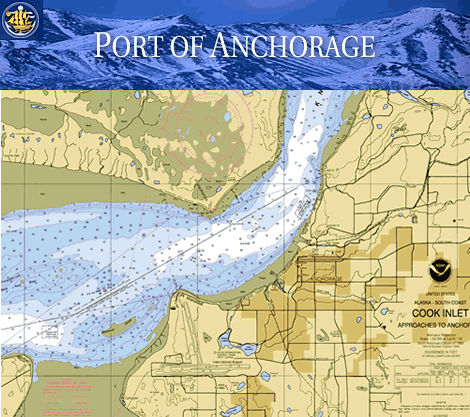Zip code 99501 Borough Anchorage | Municipality Anchorage Owner Anchorage | |
 | ||
1st amendment test at the port of anchorage poor quality audio
The Port of Anchorage (POA) is a deep-water port located in Anchorage, Alaska with 3 bulk carrier berths, two petroleum berths, and one barge berth. It is an enterprise department of the Municipality of Anchorage. As such, the Port is distinguished from other types of municipal departments largely because it generates enough revenue to support its operations without being a burden to Anchorage property tax payers, and it also pays a fee-in-lieu of taxes to help run city government.
Contents
- 1st amendment test at the port of anchorage poor quality audio
- Map of Port of Anchorage Anchorage AK 99501 USA
- Geography
- Climate
- Ice
- History
- Carriers
- Rail
- Truck
- Maritime services
- References
Map of Port of Anchorage, Anchorage, AK 99501, USA
The POA provides critical transportation infrastructure to the citizens of Anchorage and to a majority of the citizens of the State of Alaska both within and beyond the Railbelt. Seventy-four percent of all the waterborne freight and ninety-five percent of the refined petroleum products entering the state through Southcentral Alaska ports is shipped through the Port of Anchorage. This includes 100 percent of the jet fuel supplied to Joint Base Elmendorf-Richardson and approximately 66 percent of the jet fuel for Ted Stevens Anchorage International Airport.
The Port Director is appointed by the Mayor and reports to the Municipal Manager. There is a nine-person Commission, also appointed by the Mayor, responsible for promulgating the Port’s terminal tariff. Despite its enterprise distinction, the Port acts as a standard municipal department with the Anchorage Assembly approving its annual budget, contracts, tariffs, and leases. Additionally, needed legal, financial and other day-to-day support are provided, for a fee, by the appropriate general government departments acting as an extension of the Port’s staff. All Port operating activities are subject to municipal code.
Geography
The Port of Anchorage is located on the Anchorage side of the Knik Arm of the Cook Inlet on the Pacific Ocean.
A 128.96-acre (52.19 ha) industrial park adjoins the port to the east. Approximately 80.87 acres (32.73 ha) of the park are under long-term lease to various port users. Additionally, there are 31.0 acres (12.5 ha) for the staging and storage of marine cargo in transit. However, a majority of that acreage is presently occupied by the two major general cargo carriers.
Climate
The Port of Anchorage has operated year-round through extreme climate and tides.
Ice
Typically between October and November, pan ice develops in the Knik Arm of the Cook Inlet but does not fully freeze over for the winter.
Between March and May, the pan ice melts.
Since opening day in 1961, the Port of Anchorage has been able to accommodate a regular schedule of cargo delivery to Alaska's Railbelt. Operations have never been stopped due to icy conditions.
History
The Port of Anchorage began operations in September 1961, and in its first year over 38,000 tons of marine cargo moved across its single berth. It was the only port in South Central Alaska to survive the 1964 Good Friday earthquake and became the main shipping hub for consumer and essential goods entering southcentral Alaska. The Port has since expanded to a five-berth terminal providing facilities for the movement of containerized freight, iron and steel products, bulk petroleum, and cement. The peak of the port's operations occurred in 2005 when, for the first time, more than 5 million tons of various commodities moved across its docks. The port celebrated its 50th year of service in 2011.
In the late 1990s, following studies of then-existing and projected future needs, geotechnical and structural design studies and an Environmental Assessment prepared under the direction of the U.S. Maritime Administration (MARAD), the final Environmental Assessment identified a proprietary design known as Open Cell Sheet Pile (OCSP) as the preferred alternative for the wharf and berthing area of the new expansion project. Construction began in 2006 in an area known as the North Backlands. Installation of the OCSP system began in 2008, the result of which was creation of a barge berth and approximately 60 acres of new land.
The existing port was substantially built in the late 1950s and is reaching the end of its useful life. Beginning in 2017, the Port of Anchorage is undertaking an extensive 7-year Anchorage Port Modernization Project to upgrade its aging infrastructure, support larger deeper draft vessels, and future proof the port seismically and environmentally for another 75 years.
Carriers
Anchorage is served regularly by two major carriers, Matson Navigation Company (formerly Horizon Lines, Inc.) and Totem Ocean Trailer Express (TOTE), which bring four to five ships weekly from Tacoma, Washington. Petroleum tankers supply jet fuel for airport operations, barges on-load petroleum products for western and Interior Alaska, and ships from Japan and Korea call frequently, transporting construction materials, pipeline for the north slope, or loading refined petroleum.
Rail
Direct connection to Alaska Railroad, a Class II railroad serving South Central Alaska and Interior Alaska.
Truck
Nearby truck access to the Alaska intrastate highway routes:
Maritime services
Port facilities include three cargo terminals and two petroleum terminals. Gantry Crane and roll-on, roll-off capability On terminal Class 1 rail service Immediate major Alaska highway access Experienced, 24/7 security force Expertise handling multi-modal project cargo Over 50 years supporting Alaska in cargo, cement, fuel, etc.
Docks are maintained at a full seaway depth, which is 35 feet (11 m) to 45 feet (14 m).
The docks have excellent direct connections with the Alaska Railroad, and highway connections to Alaska intrastate highway routes.
